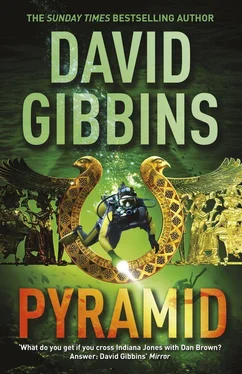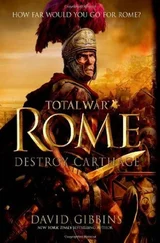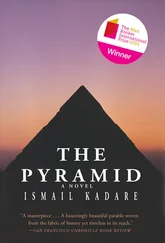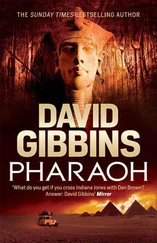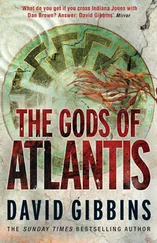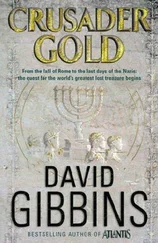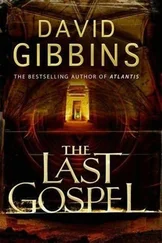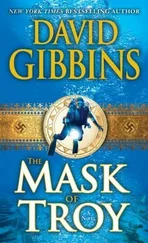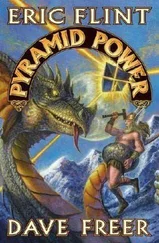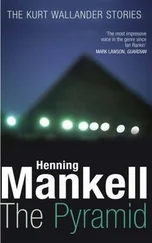Costas slapped Hiebermeyer on the back. “There you go. Just say yes. Egyptology lives on.”
Jack turned to Costas and cracked a smile. “And you, my friend, have free rein to go and tinker with submersibles. There’s a possible Egyptian wreck off Sicily I’ve always been meaning to visit that might just need your expertise, and provide the stepping-stone we need to take this theory forward.”
Costas’ eyes lit up. “That’s even better than a beach holiday, Jack. Way better. With Maurice’s gin and tonic, of course. And you’ll be amazed at what my guys have come up with while we’ve been crawling down slimy tunnels under the desert. I can’t wait to show you.”
They began to disperse, and Jack sat back, exhausted but elated. The horizon had suddenly opened up for him again, and the possibilities seemed endless. He stared at the map, his eyes narrowing. He had that feeling again, the overwhelming instinct that he was onto something big, as big as any quest he had pursued before. He felt the ship’s engines begin to throb, and he looked out to sea, already planning the next few days, his mind racing.
Game on .
I’m most grateful to my agent, Luigi Bonomi, and to my editors, Tracy Devine and Sarah Murphy in New York, and Marion Donaldson and Sherise Hobbs in London; to my previous editors Caitlin Alexander and Martin Fletcher; to Crystal Velasquez and Kay Gale for their copyediting; to the rest of the teams at Bantam Dell and Headline, including Jo Liddiard, Jane Morpeth, Tom Noble, and Ben Willis; to the Hachette representatives internationally, including Donna Nopper; to Alison Bonomi, Amanda Preston, and Ajda Vucicevic at Luigi Bonomi Associates; to Nicky Kennedy, Sam Edenborough, Mary Esdaile, Julia Mannfolk, Jenny Robson, and Katherine West at the Intercontinental Literary Agency; to Gaia Banks and Virginia Ascione at Sheil Land Associates; and to my many foreign publishers and their translators.
I owe a continuing debt to Ann Verrinder Gibbins for her critical reading of all my writing, and for her support. The formative period of travel and fieldwork behind this novel was funded by the Winston Churchill Memorial Trust, the British School of Archaeology in Jerusalem, the Palestine Exploration Fund, and Corpus Christi College, Cambridge. I’m grateful to the staff of Cambridge University Library for allowing me to examine original documents from the Cairo Geniza when I was a graduate student there, to the Royal Engineers Museum and Library in Chatham for help with research on the officers who appear in this novel, and to Peter Nield for introducing me to recent work on the life of the caliph Al-Hakim. Finally I owe a special thanks to my daughter for organizing a trip to the Black Country Museum in England, where I was able to “wall-walk” a barge in an underground canal just as I have imagined happening in Egypt more than three thousand years ago.
Hidden wisdom and concealed treasure: what is the use of either?
— From
Ben Sira (
Ecclesiasticus , the Book of Wisdom), c. third to second century BC, in the Cairo Geniza
The idea that the Giza plateau in Egypt might contain underground passageways and chambers has long fascinated archaeologists, particularly following the discovery in the 1950s of two pits beside the Pyramid of Khufu containing the pharaoh’s funerary boats. The existence of mortuary temples, man-made harbors, and canals leading from the Nile has long been known, and was given further credence when digging for a new sewage system under the adjacent suburb of Cairo in the 1980s revealed tantalizing evidence for further structures — one of them a huge mud-brick wall interpreted by some as part of a “palace” or priestly complex. The engineering feat in cutting these waterways is in many ways as extraordinary as the construction of the pyramids themselves. Despite being one of the most intensively studied sites in the world, there is much about the Giza plateau that remains open to speculation, including the possibility of subterranean complexes that have been inaccessible to exploration and lie beneath the range of ground-penetrating radar.
A further possibility, that such a complex might contain an extraordinary revelation, a secret hidden away by a heretical pharaoh, is the basis for this novel. By the time of the New Kingdom, more than a thousand years after the pyramids had been completed, it seems likely that the cults of the three individual pharaohs of the Giza pyramids had coalesced into one, and that this unified cult had become associated with the worship of the sun god Ra. When Amenhotep IV — the future Akhenaten — discarded the old religion in favor of his new sun god, the Aten, and changed his name accordingly, he may have sought a new cult center away from the traditional focus of priestly power in Thebes, and chosen instead a place that remained the oldest and most powerful expression of kingly power in Egypt and already had a strong association with the worship of the sun. Akhenaten was one of the greatest builders of all the pharaohs, with new temples at Heliopolis, not far from Giza, and at Luxor, not to speak of his magnificent new capital at Amarna. The idea that he might have directed that energy to a new complex at Giza — drawing on all the experience in rock cutting, canal building, and large-scale schemes evident in the Old Kingdom structures — is a compelling one, and plausible in terms of the engineering and architectural ambitions that his builders were capable of realizing.
Some of the inspiration for this idea of a later pharaoh “reinventing” the Giza site comes from the Pyramid of Menkaure itself, where the archaeological evidence suggests a complex picture of restoration and reuse and even the reburial of the pharaoh some two thousand years later in the 26th Dynasty, in a wooden coffin that you can see today in the British Museum. It is the only artifact collected by the British colonel Richard Vyse from the pyramid in the 1830s not to have disappeared with the sarcophagus in the wreck of the Beatrice , the coffin fragments having been despatched in a separate shipment that made it safely to London.
As well as being a builder, Akhenaten was a thinker; for most of the other pharaohs we can say little about the life of the mind, constricted as they were by the kind of priestly ritual and control that the young Amenhotep IV clearly despised. The fact of his conversion makes him intellectually the most interesting of all the pharaohs. I have speculated that instead of mysticism his revelation may have stimulated a clarity of thought that led him to gather together all the ancient knowledge and wisdom as an expression of his cult, and that the same kind of incentive that we might identify in the foundation of the Great Library of Alexandria almost a thousand years later was rooted in a memory of this center of learning lost in the desert of the Giza Plateau after Akhenaten’s death. Its very secrecy, buried out of sight and known only to a select priesthood, would have reflected Akhenaten’s certainty that his new cult would not long outlast his death, ensuring that knowledge of the place was quickly lost and showing how such a complex might have survived intact without being looted through the ages to the present day.
* * *
The possible association of Akhenaten with the Old Testament prophet Moses has been another constant source of fascination. In his book Moses and Monotheism , Sigmund Freud speculated that Moses was in fact an Egyptian of royal birth, and came close to conflating the two. It is certainly striking that the monotheism of Aten worship and the revelations said to have been experienced by Moses could have been contemporaneous, and that Moses and Pharaoh are presented in the biblical narrative in such close connection with each other. If there was indeed a revelation in the desert, shared perhaps by an Egyptian prince and an Israelite slave, then it was to be in the Judaeo-Christian tradition and later in Islam that the monotheism arising from that revelation survived, with Egyptian religion reverting back to its traditional polytheism after Akhenaten’s death.
Читать дальше
